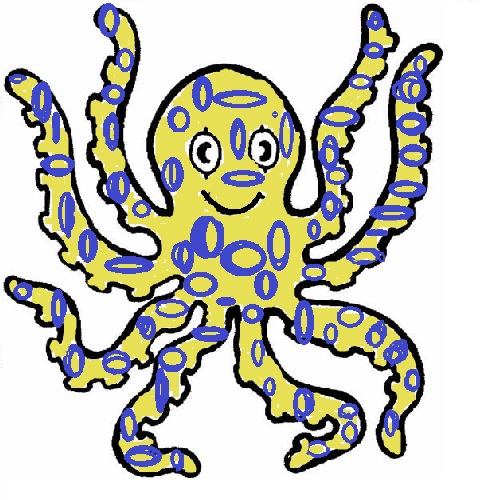

Welcome to the species page for...
The Greater Blue-Ringed Octopus!
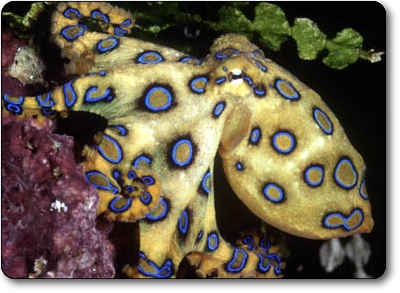 |
| Photo courtesy of Roy Caldwell |
Hapalochlaena lunulata (Quoy & Gaimard, 1832)
| | | Introduction | | DID YOU KNOW...? | | Where in the world? - Habitat and distribution | Taxonomy and classification | Physical description: Familia Octipodidae: | | | | | Hapalochlaena lunulata: | | Feeding habits | Life history and behaviour | Watch the Greater Blue-ringed Octopus in action! | H. lunulata and Humans | Conservation | Useful Links | Fun and Games | References: | Comments |
Introduction
There are currently four species of blue-ringed octopuses described, all of which are characterised by the bright blue spots that appear on their bodies when alarmed. These creatures are small in size, about 7 cm across, but they can produce enough venom to kill a human being with a single bite! Their unique colour pattern is a defense mechanism to warn predators to stay away. It is no wonder that the name of this particular species, Hapalochlaena lunulata, translates to "soft-skinned and covered in little moons" in Latin, after the large iridescent blue rings that cover the dorsal side of the mantle and web and extend to the arms. The name “greater blue-ringed” refers to the size of the rings that are displayed by these octopuses, rather than the size of the body itself. When the tiny Blue-ringed Octopus is threatened, its faint blue rings become bright and vivid. The color warns predators to back off, and with good reason — it’s one of the most deadly venomous creatures on Earth.DID YOU KNOW...?
- Don't let their tiny size fool you. Hapalochlaena lunulata carries enough venom to kill 26 human adults within minutes, making it one of the deadliest marine animals! However, this species is not aggressive and will only bite if provoked.
- H. lunulata are highly prized organisms. An individual has been sold for $4000 at an auction in Sidney, Australia
- To date, 3 fatalities have occured involving this species, one of which being in Singapore.
- Octopuses, along with squid and cuttlefishes have a short lifespan of about 2 years. Males die after mating, while females die after giving birth
- Octopus blood is a poor carrier of oxygen, which means they tire easily. They rely, instead, on a circulatory system involving three hearts and high blood pressure
- They have an incredible ability to regenerate an injured or lost arm, or even part of a damaged eye. They can fully regenerate an arm in 6 weeks.
- Octopuses are highly intelligent creatures. They have excellent sensory perception and can learn to do unfamiliar tasks by watching other octopuses
Where in the world? - Habitat and distribution
Octopuses such as the Greater blue-ringed octopus can be found in a variety of habitat types, including lagoons, bays, back reefs, and reef flats. They can be found on rosky and sandy substrates, which they can camouflage in. Hapalochochlaena sp. can be found in the IndoWest Pacific and Indian Oceans. They are most commonly found in the cooler, shallow waters off the southern coast of Australia, and can also be found along the coasts of Northern Australia. Their range can extend farther north in the tropic western Pacific Ocean, up to Japan. They can be found in shallow reefs and tide pools from northern Australia to Japan, including Papua New Guinea, Solomon Islands, Philippines, and Indonesia and as far west as Sri Lanka. Vertically, they can live at depths reaching 20 metres.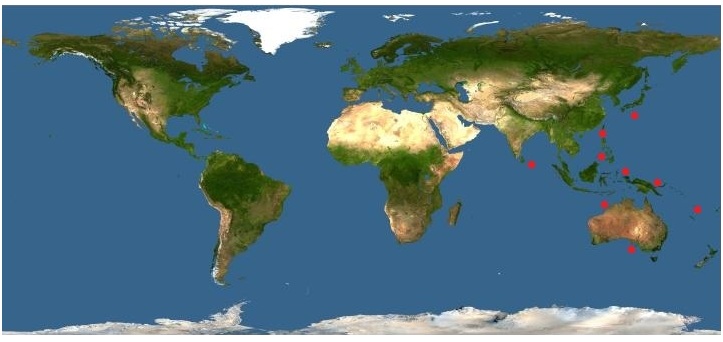 |
| Distribution map provided by John Pickering via discoverlife.org |
Taxonomy and classification
Octopuses such as the Greater blue-ringed are part of the Cephalopoda class, which is the same taxonomic group where squid and cuttlefish can be found. Hapalochlaena lunulata was first discovered and described in 1832 by Quoy and Gaimard, two French naturalists. However, they initially placed the species under the name Octopus lunulatus. It wasn't until 1929 when Robson described the genus Hapalochlaena that it was renamed, making the original name the basionym. The accepted and preferred name today is Hapalochlaeta lunulata.To learn more about type specifications, click here
To see the original species description (in French) by Quoy and Gaimard, click here
To learn how to locate the holotype, click here
Physical description: Familia Octipodidae:
Members of the Octipodae family have soft bodies that rapidly change color and texture. An octopus has no skeleton and therefore is a master excape artist due to its highly compressible body. Octopodidae can squeeze through an opening no bigger than one of its eyeballs. The octopus's musculature is unique in that the fibres run in three directions, which casues it to change shape and allow it to be incredibly flexible. Like all members of the Mollusca phyllum, Octopodidae possesses a mantle. The "skin" of Octopodidae are covered with chromatophores, pigment cells that can be expanded or contracted like a muscle. These cells vary in color, and as they are expanded or contracted, the colour changes. |
| The resting colouration and scale of H. lunulata. From http://forum.globaltimes.cn/forum/showthread.php?t=14587 |
The central nervous system of the octopus is the largest and most complex of all invertebrates, and are comparable to many vertebrates, including mammals. Also as with vertebrates, Octopodidae possess two large, complex eyes and have excellent vision. A major distinguishing feature of Octopodidae is its eight muscular tentacles, each containing two rows of independently moving suckers. A single octopus can have thousands of suckers, and and each sucker may have 10,000 neurons to sense both taste and touch.
.
.
Hapalochlaena lunulata:
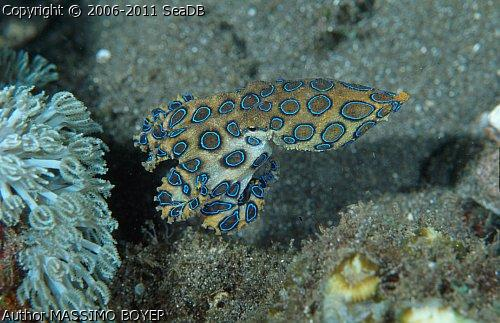 |
| Photo courtesy of Massimo Boyer |
.
Feeding habits
H. lunulata is carnivorous, feeding primarily on fish, crabs, molluscs and other small marine animals. It employs a variety of feeding techniques, such as luring its victim by wiggling the tip of an arm like a worm. It can also glide near and pounce on a crab, trapping it in its arms and dragging it towards its powerful beak-like jaws. Once it has bitten its prey, the octopus injects it with its poisonous saliva to kill it. H. lunulata can crack its prey open with its powerful jaws and removes any edible parts with the tips of its arms.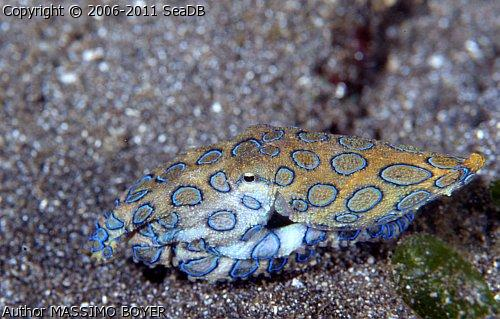
Photo courtesy of Massimo Boyer
Life history and behaviour
When a male is interested in mating, he approaches a female and gets close enough to stretch out its third arm, called a hectocotylus, to caress the female. After a period of caressing the female, the male climbs on the female, at times completely engulfing the female's mantle. The hectocotylus is inserted under the mantle of the female and spermatophores are released into her oviduct through the groove on the hectocotylus. Females can lay 60-100 eggs, which she carries in a cluster underneath her tentacles and then guards for the next 50 days. After hatching, the pea-sized larvae spend their first weeks drifting as oceanic plankton. When the planktonic larvae grow heavier, they sink to the floor. The young mature quickly and are sexually active after just 4 months. Adult females stop eating while brooding thier eggs, which is why the mother dies soon after she lays her eggs, whereas the males die shortly after mating. 
Like most octopuses, H. lunulata leads a mostly solitary life, except for when mating. It is a territorial animal, so if a confrontation does lead to competition, they attack competitors similarly as it would with prey. Because of its unusual design, Octopodidae have many different modes of locomotion. They can use their arms for grasping or to aide in swimming, which allows it to crawl along the ocean floor or, sometimes, out of the water. Its usual direction of swimming is "backwards" (i.e., away from the tips of the arms), using jet propulsion of water to propell itself through the water. They can also move themselves in the opposite direction and swim with their arm tips pointing forwards. Octopuses can also crawl over reefs, searching for hidden prey.
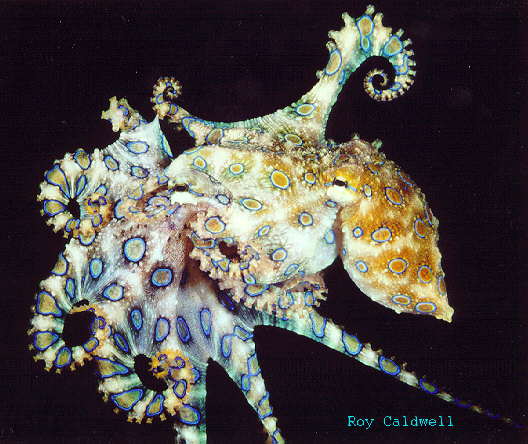 |
| Two Greater Blue-ringed octopuses mating |
There has been debate over whether the colouration changes are also serving a communicative purpose, The pulsating blue could be both a warning to potential predators and as a means of communicating amongst themselves. Octopuses are considered the most intelligent invertebrates and can learn after very little trial and error, and by observing other octopuses. Numerous studies have shown that an Octopus who watches another do an unfamiliar task will be able to do it as well. They have a variety of behaviors that are employed for concealment, defense, courtship, and more. They can change shape with amazing speed from a completely flattened, formless body to a threatening, upright shape. They can disrupt their outline by changing the shape of the mantle, waving their arms, and manipulating the papillae to alter their texture and appearance.
.
Watch the Greater Blue-ringed Octopus in action!
H. lunulata and Humans
Hapalochochlaena sp.has proven to be fatal to humans, and especially to young children. The octopus injects neuromuscular paralyzing venom that can kill humans in minutes. Of the 3 fatalities that were recorded from H. lunulata bites, 1 occured in Singapore, and all have involved the animal being handled. The bite itself may not even be felt, however a few minutes later, the victim may experience dizziness and difficulty breathing. Symptoms include: nausea, vision loss and blindness, loss of senses, loss of motor skills, and finally, respiratory arrest. The venom acts to paralyze the voluntary muscles required for body movement and breathing, so victims often require artificial respiration to maintain life. The poison gradually wears off after 24 hrs, with little to no side effects.Although other members of the Octopodidae can be used for biomedical research, behavioral science research, and as a food source, Hapalochochlaena sp. are too small and too dangerous for these typical purposes. Medical and psychological research is being conducted on the tetrodotoxin neurotoxin found in its venom. There aphrodisiac effect and the toxin's ability to block voltage-sodium channels that reduce the action potential in neurons is an area of much research. They also seem to be of commercial value, due to their aesthetic appeal.
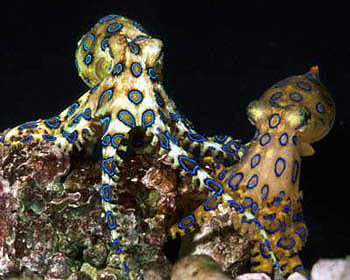 |
| Aggressive Female. photo courtesy of Roy Caldwell |
To find out more about conservation initiatives, click here
Useful Links
Octipodidae Info:http://tolweb.org/Octopodidae
Wikipedia:
http://en.wikipedia.org/wiki/Greater_Blue-ringed_Octopus
Taxanomic details:
http://www.marinespecies.org/aphia.php?p=taxdetails&id=342333
The original species description:
http://books.google.com/books?id=d0kQAQAAMAAJ&pg=PA86&ots=E2VvhTjB8I&dq=Quoy+%26+Gaimard,+1832&lr=&output=text
The Holotype:
http://biocache.ala.org.au/occurrence/5b362883-696e-4f1a-9f5c-33def61191e9
To learn more about marine conservation:
http://marinebio.org/oceans/conservation/
NCBI database:
http://www.ncbi.nlm.nih.gov/Taxonomy/Browser/wwwtax.cgi?id=102866&lvl=0
Latin language forum:
http://latindiscussion.com/forum/viewtopic.php?f=1&t=10351
Fun and Games
H. lunulata in the news:http://www.dailytelegraph.com.au/news/national/girl-finds-deadly-sea-creature-in-bath/story-e6freuzr-1225818374042
Paul the Octopus:
http://en.wikipedia.org/wiki/Paul_the_Octopus
Sea Quiz:
http://www.seadb.net/quiz.php
References:
- Buchet, P. (2010). Hapalochlaena lunulata (Quoy & Gaimard, 1832). Accessed through: World Register of Marine Species at http://www.marinespecies.org/aphia.php?p=taxdetails&id=342333 on 2011-10-28
- "Blue-ringed Octopuses, Hapalochlaena maculosa at MarineBio.org". MarineBio.org. 3 November 2011 <http://marinebio.org/species.asp?id=403>. Last updated: 9/30/2011 7:47:55 PM
- Gaimard, P., and J. Quoy. "Poulpe Lunule." Voyages De Decouvertes De L'Astrolabe. Vol. 2. Paris: J. Tastu, Editeur-Imprimeur, 1832. Print
- “Hapalochlaena lunulata, Quoy & Gaimard, 1832” Encyclopedia of Life. Available at http://eol.org/pages/491995/overview. Accessed 28-10-2011
- "Integrated Taxonomic Information Service:Hapalochlaena Lunulata." Canadian Biodiversity Information Facility. Government of Canda, 17 Mar. 2011. Web. 2 Nov. 2011. <http://www.cbif.gc.ca/pls/itisca/taxastep?king=Animalia>.
- "Ocean's Deadliest : The Deadliest Creatures : Animal Planet." Animal Planet : Pets, Wild Animals, Dog Breeds, Cat Breeds. Discovery Communications LLC. Web. 1 Nov. 2011. <http://animal.discovery.com/convergence/oceans-deadliest/deadliest-creatures/deadliest-creatures_05.html>.
- Roper, C. F. E. and F. G. Hochberg. 1988. Behavior and systematics of Cephalopods from Lizard Island, Australia, based on color and body patterns. Malacologia. 29(1): 153-193Ray, K. 2000.
- Ray, K. 2000. "Hapalochlaena lunulata" (On-line), Animal Diversity Web. Accessed October 30, 2011 http://animaldiversity.ummz.umich.edu/site/accounts/information/Hapalochlaena_lunulata.html
- Wood, James B. "Hapalochlaena Lunulata, a Blue-ringed Octopus - The Cephalopod Page." Octopus, Squid, Cuttlefish, and Nautilus - The Cephalopod Page. University of Hawaii. Web. 1 Nov. 2011. http://www.thecephalopodpage.org/lunulata.php.
Comments
Comments and suggestions are welcome! Please add anything you think is important to know below.
| Subject | Author | Replies | Views | Last Message |
|---|---|---|---|---|
| No Comments | ||||
![Taxonavigation_map[1].jpg Taxonavigation_map[1].jpg](files/Taxonavigation_map%5B1%5D.jpg)